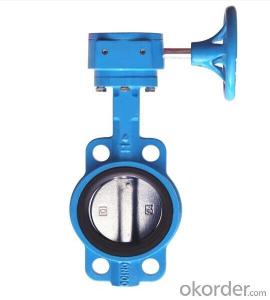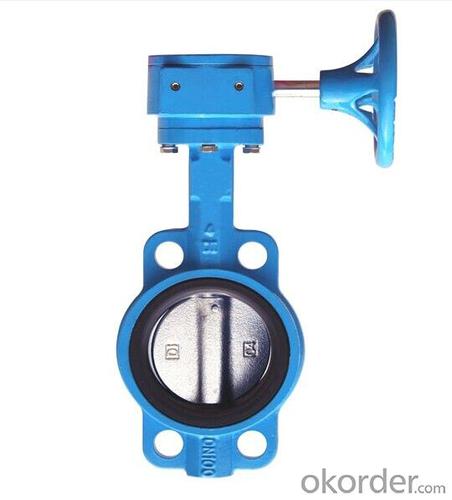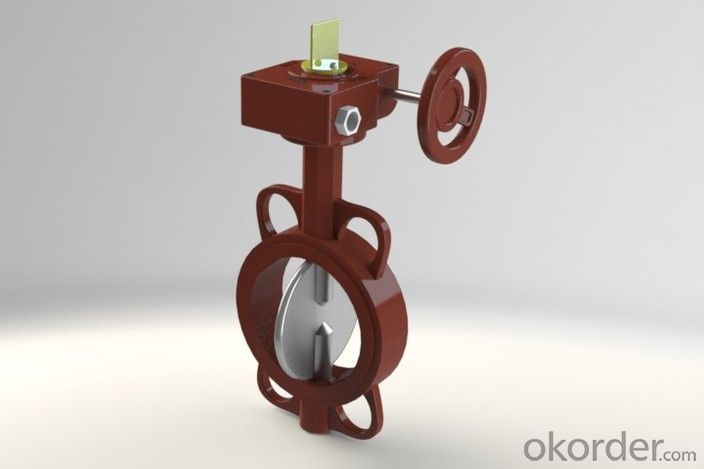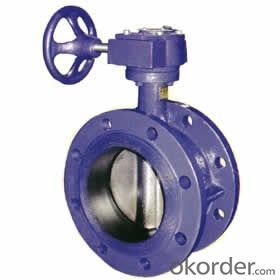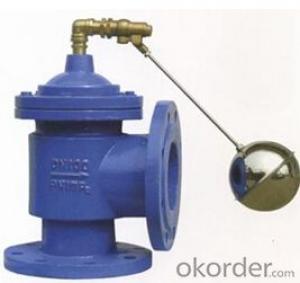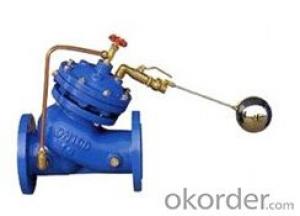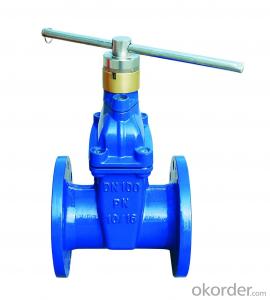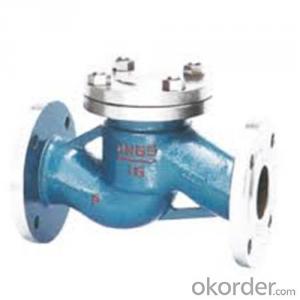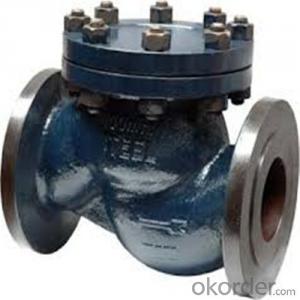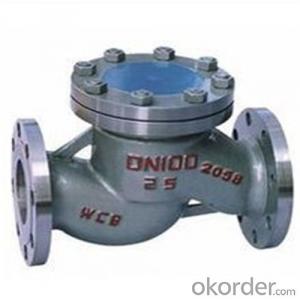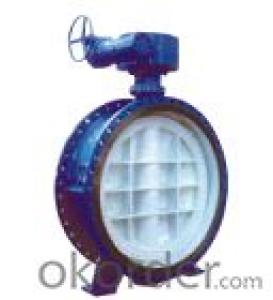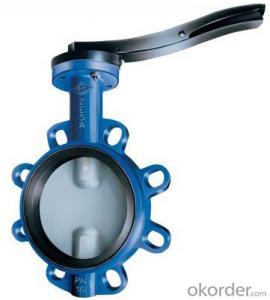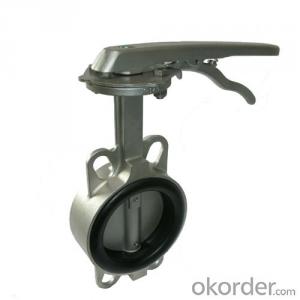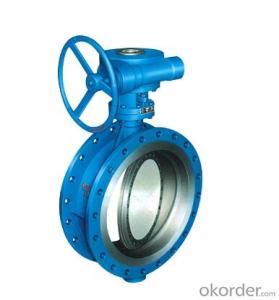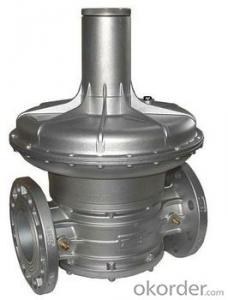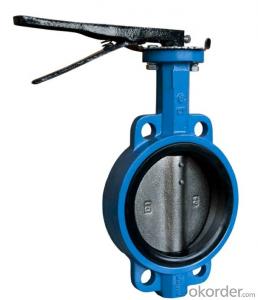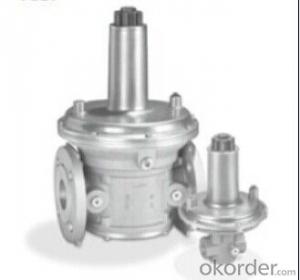Butterfly Valve DN300 Turbine Type with Hand wheel BS4531
- Loading Port:
- China main port
- Payment Terms:
- TT OR LC
- Min Order Qty:
- 1 set
- Supply Capability:
- 5000 set/month
OKorder Service Pledge
OKorder Financial Service
You Might Also Like
1. Manual Wafer Butterfly Valve Description:
A butterfly valve consists of body ,stem ,disc , actuator (manual actuator, worm-gear actuator , aerodynamic actuator or electric actuator) , and wafer type butterfly valve can implement the process for turning on turning off and regulating the flow by the circumrotation of stem and disc that is droved by actuators.
A butterfly valve is a valve which can be used for isolating or regulating flow. The closing mechanism takes the form of a disk. Operation is similar to that of a ball valve, which allows for quick shut off. Butterfly valves are generally favored because they are lower in cost to other valve designs as well as being lighter in weight, meaning less support is required.
2.Main Features of the Manual Wafer Butterfly Valve
1. Small in size and light in weight, easy instillation and maintenance. It can be mounted wherever needed
2. Simple and compact construction, quick 90 degrees on-off operation
3. Minimized operating torque, energy saving
4. Flow curve teeing to straight line, excellent regulation performance
5. Long service life, standing the test of tens of thousands opening/closing operations
6. Bubbles-tight sealing with no leakage under the pressure test
7. Wide selection of materials, applicable to various mediums
8. The material of valve body: cast iron, cast steel, cast stainless steel and so on.Soft seat. Replaceable. Increase of service life.
9Double half shaft without pin.Square and short neck. Easy to stick scutcheon and cost saving.
3. Manual Wafer Butterfly Valve Images:
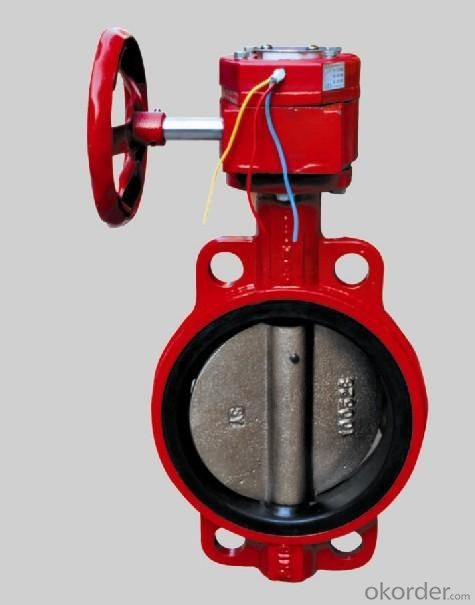
4.Manual Wafer Butterfly Valve Specification:
Size: DN50-DN1000
End flange: ANSI B 16.1,EN1092,AS2129
Face to face: ANSI B 16.10
Top flange: ISO 5211
Normal pressure: PN1.0/1.6MPa(150/200PSI)
Body: CI/DI/WCB/ALB/CF8/CF8M
Disc: DI/ALB/Rubber lined Disc/1.2501/1.4529/CF8/Hastelloy Alloy/Monel
Stem: 410/416/304/431/17-4PH/316/monel
Seat: NBR/Hypalon/EPDM/Neoprene/NR/Wear-Resistant EPDM/Viton/Silicon/Heat-Resistant EPDM/White EPDM/EPDM(NSF)/PTFE
5.FAQ
1. What is manual wafer butterfly valve?
A: Wafer style is the more common of the two and is less expensive than the lug style. The wafer style butterfly valve is just about the standard. It ís so common that no one even bothers to use the word "wafer" when ordering a butterfly valve. It is taken for granted that if a butterfly valve is ordered, a wafer style will be received.
2. How about the Installation of the Wafer Style Butterfly Valve?
A: Butterfly valves are installed by inserting the valve between two flanges using bolts or studs and nuts to hold it all together. This type of installation, of course, makes it impossible to disconnect just one side of the piping system from the valve. That benefit is received using the lug style valve.
3. What is the working principle of manual wafer butterfly valve?
A: A butterfly valve is from a family of valves called quarter-turn valves. In operation, the valve is fully open or closed when the disc is rotated a quarter turn. The "butterfly" is a metal disc mounted on a rod. When the valve is closed, the disc is turned so that it completely blocks off the passageway. When the valve is fully open, the disc is rotated a quarter turn so that it allows an almost unrestricted passage of the fluid. The valve may also be opened incrementally to throttle flow.
- Q: 1995 Firebird - with digital EGR valve, I think when the engine is at idle, it would be closed, I think.Anyway, this EGR valve has 3 holes that open up whenever.I noticed that the plastic housing on them is melting a little, which probably isn't anything.but I felt around it, and I feel a little air coming out, not from the gasket part, but maybe it has a leak in one of those solnoids somewhere.My cars been idling really ruff, do you think a leak in that would cause it to idle ruff?when I drive, it's fine, runs smooth, but stopping it idles ruff.I just bought that EGR valve 2 years ago, I don't know why it would melt.
- Take the EGR valve off and see if it is internally caked with carbon. Also look at the ports it lines up to on the plenum and see if they are also clogged with carbon. If they are, remove the air intake tube from the throttle body and open the throttle plate. See if the intake plenum is also clogged with carbon. If so, and I think it is, you will need to get yourself a cumbustion chamber cleaning. Those 90s GM cars were bad for this. This will make it idle rough, and also lack as much power as it should have.
- Q: Im replacing the valve stem seals and i dont know how to remove the springs and with the valve compressor wont fit in the engine
- Do NOT do what banit said, if you did his technique once you remove the keepers the valve would drop to the bottom of the cylinder and require a tear down. You must get the piston be at top dead center on the cylinder you intend on removing the valve springs from and you cannot do any other valves besides the ones on the cylinder you brought to top dead center. You can take the rocker arm off the top and take the push rod out then when at top dead center using a spring compressor you can take the keepers out, or if you do not have a spring compressor (proceed at your own risk) you can get an oversized socket and a dead blow hammer and place the socket over the top of the valve spring with the octagonal side towards the spring and give it a decent hit, but be aware the keepers will pop out and you may lose them if you are not careful.
- Q: Because I plan to remove mine on a 2000 Eclipse GT.Thank you all..
- I am guessing you mean will the valves come out if you remove the rocker assy. The answer to that question is no. The valves are retained by little half-moon clips that are wedged in a slot in the valve stems. The force of the valve springs against the top valve washer keeps them in place while also preventing the washer from sliding up past the top of the stem. You can remove the rocker assy without having the valves drop into the cylinders. You will have to adjust the gap between the cam lobes and the rockers when reinstalling so it isn't like you can just bolt it back on.
- Q: When and why do you need to get a valve job? My car has 85k miles on it. What is the difference between a valve-job and valve-adjustment? what would the increase in power be on mine? 3800 series 2 engine, assuming it is just a little old, no major problems. 5-10hp?
- MOST modern engines have hydraulic lifters, which pretty much eliminates the need to have any periodic valve adjustments. You can take stock heads to a shop and put two grand into them and make better flow and bigger valves and more power, or actually buy a set of performance heads for less and make more power. the only time your valves would need to be set is when putting together a new engine, or taking apart the one you have and replacing say a head gasket or something. (in which case you would have a shop go through the heads and make sure they are up to factory specs. If your engine is running fine, and you have kept the oil clean and the motor in good tune, follow the recommended maintenance intervals in your owners manual. a valve adjustment is not going to give you horsepower.
- Q: Does a diverter valve even make a sound at all?
- I have had both on my car. A blow off valve gives off a loud Hiss. If you want to know what a diverter valve sounds like when it vents, flick a metal pipe with your finger. Its kind of a metallic clink noise that is much quieter then the blow off valve. BOV's are also illegal in many places as it is venting exhaust gases to the atmosphere. BOV's are also much more likely to cause your Check engine light to come on because the mass air flow sensor has an idea of how much air should be passing by it. When you put a blow off valve in, that air pressure is vented to the atmosphere and the mass air flow can give false readings causing your fuel mixture to be changed. The diverter valve does not vent it to the atmosphere but sends it back through the intake system again so your CEL shouldnt come back on
- Q: Compare and contrast stenosis and regurgitation (insufficiency) in terms of the functional abnormality associated with the valve leaflets and their effects on hemodynamic parameters such as stroke volume.
- stenosis means thats it difficult to open the valve to allow a full ejection of blood. regurgitation is caused by an insufficient valve, in which the valve does not close all the way, and thus allows blood to flow backwards. For instance, the two AV valves (mitral on the left, tricuspid on the right), are prevented from prolapsing by chordae tendonae, which are connective tissue fibers attached to pieces of cardiac muscle (papillary muscles) on one end, and the edge of the valve on the other. If these chordae tendonae break, this may cause blood to flow back into the respective atria during ventricular systole. Valvular insufficiency and prolapse will cause diminished stroke volume. Valvular stenosis, on the other hand, is typically caused by a buildup of material on a valve which inhibits its movement. This buildup could be many different things, to name a few: valve calcification due to hypercalcemia, bacterial adhesion and growth due to sepsis, plaque (cholesterol bound with free radicals) buildup on the valve, a fibroma, etc... If the valve's opening is inhibited, and it does not open all the way, there will be a diminished blood flow into whatever chamber is next in the sequence. If an AV valve is stenotic, the ventricles may not fill properly, and preload will be low, which will lower ejection volume. If the semilunar valves are stenotic, then the ventricles will likely hypertrophy because they will need to work harder to force as much blood out, because blood entering the ventricle must equal blood leaving the ventricle with each heartbeat (starlings law of the heart).
- Q: What are the requirements for valve automation?
- Valves are commonly available for both liquid and gas. You would begin by determining operating pressure, volume, nature of fluid, and temperature of fluid. The electrical requirements are as simple as supplying power to a solenoid. Mechanically, automatic valves are sophisticated. Begin by researching the water supply valves for a domestic washing machine.
- Q: My 4.0 L V6 2002 Ford Explorer has this plastic casing on top of the intake manifold...some of the hoses (brake booster, etc) are actually connected to the plastic casing, now how can i replace my pcv valve?
- Try okorder
- Q: hi i want to now what a BOV (blow off valve) i no what it does but i dont no the instalation process what pipes and stuff are invalved and were does it go next to the turbo of air intake
- Most are designed to install on the intake/turbo piping. They're for the release of pressure surges to keep the turbo safe. Most stock bovs are not capable of raised boost which is why many buy aftermarket ones.
- Q: emission control valve toyota camry
- Is English your first language? Where is the question?
Send your message to us
Butterfly Valve DN300 Turbine Type with Hand wheel BS4531
- Loading Port:
- China main port
- Payment Terms:
- TT OR LC
- Min Order Qty:
- 1 set
- Supply Capability:
- 5000 set/month
OKorder Service Pledge
OKorder Financial Service
Similar products
Hot products
Hot Searches
Related keywords
